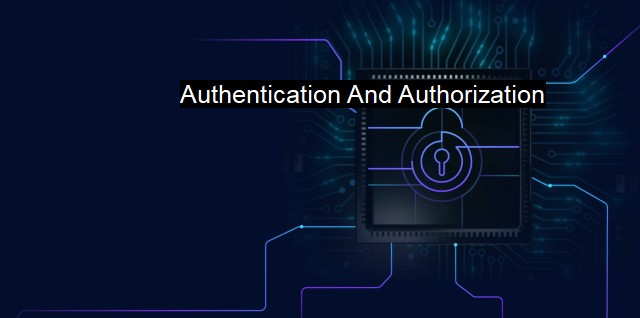What is Authentication And Authorization?
Understanding the Significance of Authentication and Authorization for Cybersecurity: Strengthening Network Security and Combating Cyber Threats with Antivirus Software.
In the vast digital landscape of cybersecurity and antivirus, authentication and authorization are key mechanisms employed to establish trust and ascertain user identity and access levels. Both concepts are fundamental to a wide range of digital operations, warranting comprehensive understanding for defenses against potential cyber threats.Drawing a closer look at authentication, it is the method of validating users' identity. Authentication confirms that an individual or a system is indeed who they claim to be with substantiated proof, often leveraging personal identification details such as an email, username, password, or even biometric data. In cybersecurity terms, authentication is by which the system seeks to deny unverified access, ensuring only legitimate users obtain passage, lessening potential risks of intrusion or unauthorized activities.
Authentication is undertaken via several methods: knowledge-based (something one knows, such as passwords), possession-based (something one has, like tokens or cards), and inherence-based (something one intrinsically possesses, namely, biometrics). There’s also the location-based and time-based authentication approach. An advanced authentication layer is multi-factor authentication (MFA), calling for authentication via trained devices; it combines various methods for more robust security, proving challenging for cyber attackers to navigate.
Once the user is authenticated, the equally-critical authorization process takes over. If authentication is the means to establish the identity, then authorization is a method to determine and provide access privileges to the authenticated identity. authorization set the rules about what users can do, what information they can access, and the actions that they can perform there within specific IT systems.
Defining user roles categorizes different users of the software to have varying degrees of permissions reflecting their roles. it decides what resources an individual user or system can access. Its main aim is to ensure that access to assets is securely managed and granted correctly. There's predefined limits preventing sensitive data exposure to unrestricted access.
The relationship between authentication and authorization is a matter of synthesized functions: authentication discerns the authenticity of user identity whereas authorization manages subsequent user actions in terms of permissible system operations. Collectively, the two practices are aimed at maintaining data security and restricting malicious activities, thus serving the cornerstone of cybersecurity systems' infrastructure.
Moving beyond the security scope, antivirus software also utilizes these elements. Antivirus software providing added security layers prompts authentication to execute higher-level functions, needing 'authorization' for desired actions. The antivirus software’s actions include scanning specific directories or files for any malware or acting upon detecting malicious activities. Hence, the principles of authentication and authorization apply.
Taking an example of role-based access control in antivirus systems, only role-endowed personnel (e.g. system admin) are authorized to change settings or schedule scans, bringing out the authorization's intricacy. Similarly, for sensitive operations like deleting infected files, user authentication checks are put in place to prevent unauthorized changes, underscoring the authentication's pertinence.
Inevitably, the process and mechanisms underlining these two entities involve rigorous algorithms, encryptions and tokens which demand constant updates and improvisations to stay ahead of increasingly sophisticated and evolving cyber threats while innovating ways to prevent potential data misuse or corruption by unapproved parties.
Authentication and authorization are integral components deeply interwoven within cybersecurity functionalities and antivirus configurations. They are substantial digital response mechanisms promoting a definitive acceptance and rejection framework, serving to fend off illicit infiltrations and facilitate responsible information access. It is thereby critical for organizations to ensure reliable authentication processes and authorization controls for fortified cybersecurity landscape. Viewer discretion and highly-trained personnel understanding the system's multiple facets would indeed empower them significantly in precluding potential cyber-attack increments.

Authentication And Authorization FAQs
What is authentication and authorization?
Authentication is the process of verifying the identity of a user or system, while authorization refers to the process of granting or denying access to specific resources or functionalities based on the authenticated user's permissions.Why is authentication and authorization important in cybersecurity?
Authentication and authorization play a critical role in cybersecurity by ensuring that only authorized users can access sensitive data, systems, and applications, thereby preventing unauthorized access, data breaches, and other security incidents.What are some common authentication and authorization methods used in antivirus software?
Some common authentication and authorization methods used in antivirus software include password-based authentication, two-factor authentication, biometric authentication, certificate-based authentication, and role-based access control.How can businesses improve their authentication and authorization protocols to enhance their cybersecurity posture?
Businesses can improve their authentication and authorization protocols by implementing strong password policies, adopting multi-factor authentication, regularly reviewing and updating user permissions, conducting regular security audits, and leveraging advanced technologies such as artificial intelligence and machine learning.| | A | | | B | | | C | | | D | | | E | | | F | | | G | | | H | | | I | | | J | | | K | | | L | | | M | |
| | N | | | O | | | P | | | Q | | | R | | | S | | | T | | | U | | | V | | | W | | | X | | | Y | | | Z | |
| | 1 | | | 2 | | | 3 | | | 4 | | | 7 | | | 8 | | |||||||